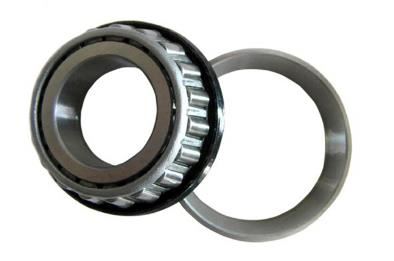First, The similarities between ball bearings and roller bearings:
1. They are all sports high pairs; the difference is that the ball and roller bearing motion pairs are point contact and line contact respectively.
2. Ball bearings and roller bearings are rolling bearings, with the characteristics of rolling bearings.

Second, the characteristics of rolling bearings
advantage:
1. Low friction resistance, low power consumption, high mechanical efficiency, easy to start.
2. The size is standardized and interchangeable, which is convenient for installation and disassembly and convenient for maintenance.
3. Compact structure, lightweight, axial size is further reduced.
4. High precision, high speed, low wear, and long service life.
5. Some bearings have self-aligning performance.
6. Suitable for mass production, stable and reliable quality, high production efficiency.
Disadvantages:
1. Noisy.
2. The structure of the bearing housing is more complicated.
3. The cost is higher.
Compared with sliding bearings, rolling bearings have the following advantages:
1. The friction coefficient of rolling bearings is smaller than that of sliding bearings, and the transmission efficiency is high. The friction coefficient of general sliding bearings is 0.08-0.12, while the friction coefficient of rolling bearings is only 0.001-0.005;
2. Rolling bearings have been standardized, serialized, and generalized, suitable for mass production and supply, and are very convenient to use and maintain;
3. Rolling bearings are made of bearing steel and have undergone heat treatment. Therefore, rolling bearings not only have high mechanical properties and long service life, but also save expensive nonferrous metals used in the manufacture of sliding bearings;
4. The internal clearance of the rolling bearing is very small, and the machining accuracy of each part is high, therefore, the running accuracy is high. At the same time, the rigidity of the bearing can be increased by preloading. This is very important for precision machinery;
5. Some rolling bearings can bear radial load and axial load at the same time, therefore, the structure of the bearing support can be simplified;
6. Due to the high transmission efficiency of the rolling bearing and low heat generation, it can reduce the consumption of lubricating oil and save lubrication and maintenance;
7. Rolling bearings can be easily applied to shafts in any orientation in space.
Rolling bearings also have certain disadvantages, mainly:
1. The bearing capacity of rolling bearings is much smaller than that of sliding bearings of the same volume. Therefore, the radial size of the rolling bearings is large. Therefore, in the case of high load and the requirements of small radial size and compact structure (such as internal combustion engine crankshaft bearings), sliding bearings are mostly used;
2. Rolling bearing vibration and noise are relatively large, especially in the later period of use. Therefore, rolling bearings are difficult to perform in situations where high precision is required and vibration is not allowed. Generally, sliding bearings are better.
3. Rolling bearings are particularly sensitive to foreign objects such as metal shavings. Once foreign objects enter the bearing, intermittent large vibrations and noises will be generated, which will also cause early damage. In addition, rolling bearings are also prone to early damage due to impurities such as metal clamps. Even if there is no early damage, the life of the rolling bearing has a certain limit. In short, the life of rolling bearings is shorter than that of sliding bearings.
However, compared with sliding bearings, rolling bearings have their own advantages and disadvantages, and each occupies a certain application occasion. Therefore, the two cannot completely replace each other, and each develops in a certain direction to expand its own field. However, due to the outstanding advantages of rolling bearings, there is a tendency for the latecomers to take the lead. At present, the rolling bearing has developed into the main support type of machinery, and its application is more and more widely.
Third, the use of rolling bearings
Rolling bearing is abbreviated as bearing. It is a widely used and demanding basic component of the machinery industry and civil appliances. It is called the joint of machinery. It can be said that as long as there is rotation, there are bearings. The wide range of use determines the variety and complexity of bearing varieties. The strict requirements determine the importance of bearing quality and performance.
The bearing manufacturing industry is a precision basic parts manufacturing industry. Its precision is measured by 0.001 millimeters (mm), while the manufacturing tolerances of ordinary mechanical parts are generally only 0.01 mm. The noise and vibration of the motor depends to a large extent on the quality of the bearing; the swing difference and temperature rise of the spindle of the high-precision machine tool are closely related to the quality of the bearing. Communication??? The bearing performance in the racemization device directly affects its communication effect; failure of key bearings in aerospace and aviation will cause serious accidents.
In short, bearings in various fields such as industry, agriculture, defense, science and technology, and civil equipment (such as your computer optical drive, hard disk, and automobile) all use bearings. Their accuracy, performance, life, reliability, and various economic indicators, are closely related to bearings, and the development of the bearing industry is also related to the manufacturing level of China's major technical equipment and the export capacity of mechanical equipment. Bearings are playing an increasingly important role in the construction of the national economy and national defense.

